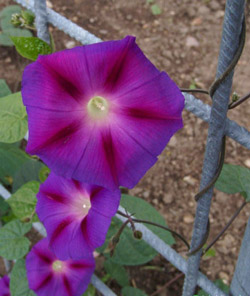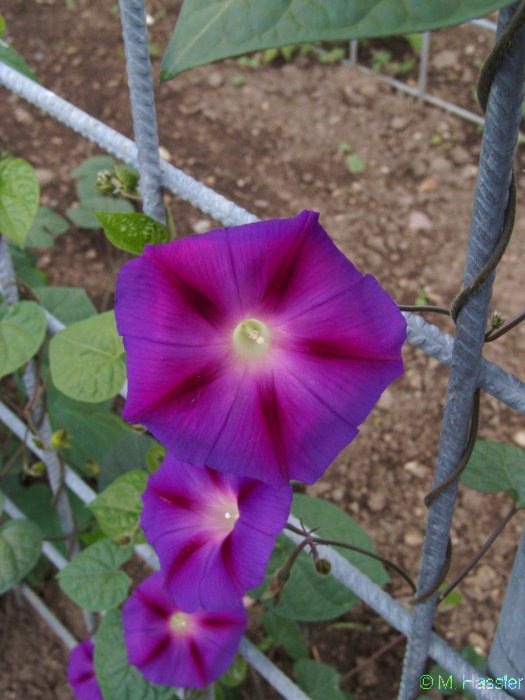String Theory for Plants
Many climbing plants use barbs, tendrils, or rootlets to attach themselves to the structures they ascend, but so-called twining plants simply wind themselves around a support and stay there without any adhesive tricks. In the 3 November PRL, researchers offer a mechanical model of how the free tip of a twining stem can hold onto a smooth support, allowing the plant to grow upward. The model also explains why these vines cannot grow on supports of too large a diameter.
A twining plant can’t hold up its own weight, so it wraps around a vertical support. As the vine pulls itself up, it generates tension along its stem, as in the taut rope of a mountain climber scaling a cliff. But botanists haven’t explained how, if the growing tip is not attached, the vine can sustain tension, allowing a “pulling” force with respect to the roots. Another puzzle, noted by botanists dating back to Charles Darwin, is that these plants can’t wrap around supports that are too fat, like a large tree trunk.
To address these questions, Alain Goriely of the University of Arizona in Tucson and Sébastien Neukirch of the University of Paris theoretically modeled a twining plant, first reducing the problem to two dimensions–a vine growing around a disk, like thread on a spool. In the model they assume the plant to be tightly wrapped around the disk except for a short free segment at its tip, which they imagine as something like a curved piece of wire, securely attached at its base to the edge of the disk.
The vine segment is more tightly curved than the disk, so it forms an arc touching the disk only at the anchor point and at the tip. This arc is under stress, pressed against the disk from the anchor point, where it emerges from the wound-up part of the stem. The stress slightly distorts the arc’s shape. The vine’s tip is free to slide along the disk’s circumference, but the researchers found that there are stable configurations, in which sliding the tip either way would only increase the stress. In such an equilibrium, the stress in the vine creates tension along it, just as trying to straighten a curved piece of springy wire will generate a resisting force that tries to pull the ends together.
In this way, Goriely and Neukirch argue, a twining plant can be in a state of tension, with its tip held in place purely by static forces–the fact that moving would only increase the stress–even in the absence of friction or adhesion. The only force at the contact point is the so-called normal force of the disk pressing straight outward against the tip.
The team found that if the disk is too large–with a radius of more than about 3.3 times the intrinsic radius of curvature of the vine section–there is no stable position for the tip along the disk. A large disk is equivalent to a tightly curved stem, one that loops back and crosses itself like a curlicue, touching the disk at one point along its arc. Such a curled-up stem grazes the disk at too shallow an angle to establish a stable contact, which requires the vine tip to touch the disk at a nearly 90-degree angle, the team found.
A full three-dimensional treatment of the problem is more complicated, involving intrinsic twist as well as curvature, but Goriely and Neukirch tackled a simplified 3D model and found that the broad principles of their argument remain true. The way twining plants climb is “a longstanding and fascinating problem,” says plant biologist Michele Holbrook of Harvard University. “It’s great to see physicists getting interested.”
–David Lindley
David Lindley is a freelance science writer in Alexandria, Virginia.





